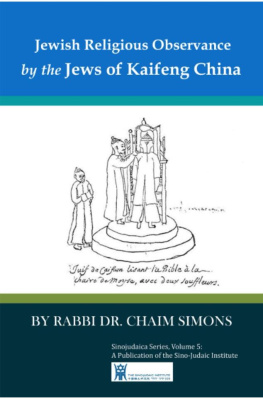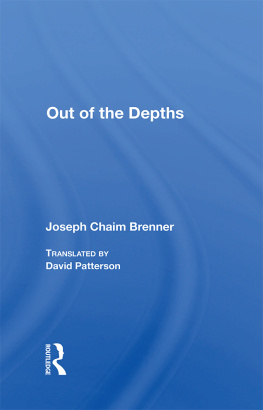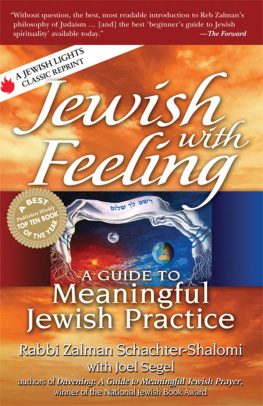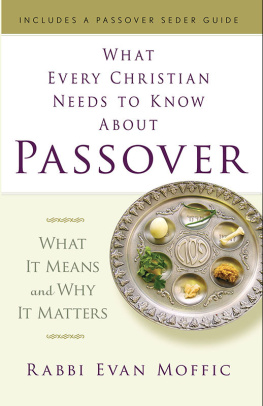THE
SACRED
AND THE
PROFANE
THE
SACRED
AND THE
PROFANE
THREE NOVELLAS
CHAIM GRADE
translated from the Yiddish by
Harold Rabinowitz
and Inna Hecker Grade

A JASON ARONSON BOOK
ROWMAN & LITTLEFIELD PUBLISHERS, INC.
Published in the United States of America
by Rowman & Littlefield Publishers, Inc.
A wholly owned subsidiary of The Rowman & Littlefield Publishing Group, Inc.
4501 Forbes Boulevard, Suite 200, Lanham, Maryland 20706
www.rowmanlittlefield.com
Estover Road
Plymouth PL6 7PY
United Kingdom
I wish to thank Harold Rabinowitz for his painstaking work on this translation, and Melvin Rosenthal and Ashbel Green, editors at Knopf, for their help and good counsel both before and after the sudden passing of my dearest husband, Chaim Grade.
Inna Hecker Grade
Published by arrangement with Alfred A. Knopf, Inc.
This book was set in 12 pt. Garamond by FASTpages of Nanuet, NY.
First Jason Aronson Inc. edition1997
Copyright 1982, 1997 by Estate of Chaim Grade
All rights reserved. Printed in the United States of America. No part of this book may be used or reproduced in any manner whatsoever without written permission from Jason Aronson Inc. except in the case of brief quotations in reviews for inclusion in a magazine, newspaper, or broadcast.
Library of Congress Cataloging-in-Publication Data
Grade, Chaim, 1910
[Kloyz un di gas. English. Selections]
The sacred and the profane / by Chaim Grade.
p. cm.
Translations from Yiddish.
Originally published: Rabbis and wives. 1st ed. New York : Knopf, 1982.
Contents: The rebbetzin Laybe-Layzars courtyard The oath.
ISBN 1-56821-963-6 (alk. paper) ISBN 978-1-5682-1963-9
1. Grade, Chaim, 1910 Translations into English. 2. Jews
Social life and customsFiction. I. Title.
PJ5129.G68K5132 1997
839'.134dc21 978196
 The paper used in this publication meets the minimum requirements of American National Standard for Information SciencesPermanence of Paper for Printed Library Materials, ANSI/NISO Z39.48-1992.
The paper used in this publication meets the minimum requirements of American National Standard for Information SciencesPermanence of Paper for Printed Library Materials, ANSI/NISO Z39.48-1992.
Printed in the United States of America
CONTENTS
Glossary
Foreword
CHAIM GRADES READERS may wish to ask why this volume, originally published in English as Rabbis and Wives, is now being reissued under the title The Sacred and the Profane. I must assume the full responsibility for the change. Rabbis and Wives can mislead readers, making them overlook the essential message of the book, that human life is a tension of opposites, a tension between the sacred and the profane, that it is in the nature of the profane to wage war on the sacred. Yet, in the end, human yearning for the spiritualthe eternalspiritualizes and redeems even the war of the sacred and the profane.
In Yiddish, the title of this volume, Die Kloyz un die Gassliterally, The Synagogue and the Streetmeans precisely The Sacred and the Profane. As we were translating the text, it occurred to me that, since it deals with great rabbinic families, it might be called in English Rabbis and Wives. But now I am grateful for the opportunity to publish this book with its proper title.
Chaim Grade wrote the three novellas of The Sacred and the Profane after finishing his two-volume novel, Tzemah Atlas known in English as The Yeshiva, and before beginning work on his ultimate masterpiece, The Old House, which is awaiting completion of an English translation. In Tzemah Atlas, the emphasis is mainly on masters and disciples, while The Old House is based on relationships between parents and children. The novellas fo The Sacred and the Profane serve as a bridge between the other two works, as well as to the poetry of Grades later years.
These novellas offer much for the reader to ponder. The Rebbetzin concerns a rabbinical Lady Macbeth, who, in a society that suffers a loss of faith, has mastered the art of walking on corpses and achieves almost all she desires. Laybe-Layzars Courtyard is about a zealot who attempts to rule his family with an iron hand and a gentle rabbi who searches for ways to mitigate the law. The Oath, among other things, tells of rabbis who were blind about the Nazi evil that threatened European Jewry, but prophetically foresaw the ominous consequences of Communist oppression.
There is much that I could write about The Sacred and the Profane, or the other works of Chaim Grade, but the limitations of space cause me to be brief here.
Inna Hecker Grade
January 1997
THE
REBBETZIN
1
THE GRAIPEWO RAV and his wife had reached their later years. Their children were all married and lived in Horadna. The Rav, Rabbi Uri-Zvi HaCohen Koenigsberg, was a huge, fleshy man, tall and wide, with wavy sidelocks flowing into a snow-white beard and large, innocent light-blue eyes. Though widely respected as a scholar and preacher, Rabbi Koenigsberg had never sought a more prestigious pulpit. He remained in Graipewo, never arguing with his congregants or ruling them with an iron handand never flattering the wealthier of them either. It was his wish to avoid contention at all cost.
When litigants came before him for a ruling, he was so persistent in urging them to settle the dispute themselves that only rarely did he have to render a verdict. When the townspeople urged him to rebuke the young men who were straying from the right path, he would never publicly chastise the impudent youths in his sermons. Instead, he would come down where they congregated and talk to them behind the bima; he would even seek them out in the marketplace. And there was a great deal to reproach these young men for: much desecration of the Sabbath, and cavorting with girls by the river, and just plain recklessness. But the Rav would simply ask them: How long is one young?and continue plaintively, Youre all going to be older someday. And youll be ashamed all your life for what you are doing now. Is this proper for children of such nice homes as yours? He would say this with such anguish and sincerity that even the most brazen youths would not dare to answer back.
With the same solemnity and care with which he chanted the morning prayers he conducted classes in Mishnah every morning after services. And so clear and simple were his explanations that even a child could understand. With that same patience did he eat, study, write out his Talmudic insights, and prepare his sermons. And when he grew tired, he would stroll down the path behind his house. Calmly, with his hands clasped behind him, he would walk, half murmuring, half chanting to himself a song of praise to God for such a beautiful day.
If he met anyone on the way, he would nod amiably without waiting to be greeted first, and then continue his brisk stroll to a pleasant, barely audible melody. But should a man approach him looking worried and say, Rabbi, Id like to ask your advice, his entire demeanor would express concern and he would hear out the mans problem right there on the road. He would then take the troubled man into his home and, in private, continue to listen until the man had finished pouring out his heart and could leave consoled.
Even the more contentious among his congregants respected and admired the Ravs humility. Once the president of the congregation remarked: The Rav, may he live and be well, is beloved and esteemed by all of us, and Graipewo would not think for a moment of his leaving. But we wonder, why is it that the Rav has never sought a larger congregation, as so many of his colleagues have done?
Next page








 The paper used in this publication meets the minimum requirements of American National Standard for Information SciencesPermanence of Paper for Printed Library Materials, ANSI/NISO Z39.48-1992.
The paper used in this publication meets the minimum requirements of American National Standard for Information SciencesPermanence of Paper for Printed Library Materials, ANSI/NISO Z39.48-1992.